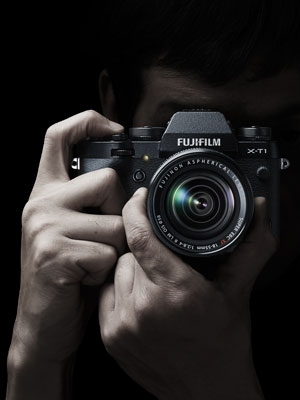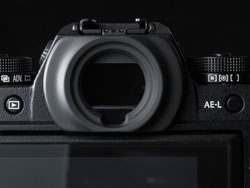Beautiful finish, nice tactile feel and responsive controls — Fujifilm’s latest X-T1 mirrorless X series camera is certainly an as impressive as elegant photographic tool the Japanese camera maker can be proud of. Bear in mind, the X series is only two years old. Within no time the retro-styled cameras have grown into a respected lineup of serious cameras for enthusiasts and pros alike — and the X-T1 with the highly thought of 16MP X-Trans II sensor not only upholds Fujifilm’s long tradition of quality optical instruments, it refines the X series and takes it to a new level.
+++ All sample images are downsized, slightly compressed, straight out of camera JPEGs without any noise removal applied.
+++ For specs and more information download the Fujifilm X-T1 brochure. You can order the Fujifilm X-T1 from Amazon (body / kit), B&H (body / kit) and Adorama (body / kit).

Still, coming from “conventional” digital cameras the innovative X-T1 might not be the most intuitive at first glance. You’re looking in vain for a PASM dial. Shooting mode? The X series approaches modes in a different, more back-to-the-roots and at the same time forward-looking manner.
Either use the aperture mode switch on the lens to toggle between auto and manual aperture control. Or use the ISO or shutter speed dials’ A modes to switch between P and M. Why I bring this up — and make a fool of myself? As it’s certainly not politically correct:
Every time I shoot new gear the learning curve says something about the camera’s ease of use. Don’t want to be held back by having to learn new gear again and again. Intuitive gear gives me better photographs, it’s as simple as that.
What PASM Dial?
The X-T1’s design is a hybrid between OM-D and classic SLR, yet with its functions and controls Fujifilm’s engineers see the X-T1 as a natural, logical evolvement of photography. Call me antiquated, but first I missed the PASM dial. Don’t get me wrong. Am a diehard Contax G2 guy. Having mutated into a digital creature of habit, it’s first unusual and quickly considerably enticing to use a PASM-less digital camera — if only the access to M and P mode were more intuitive. Thank you Fujifilm for relieving the camera of this digital era clutter. Which fool invented the redundant PASM dial, ‘Nuff asked? It’s a practical component of most serious digital cameras. Even the ultra retro Nikon Df has a very prominent PASM dial. Love it. Use it. Yet Fujifilm goes for thoughtful X cameras and prefers to go back to the basics of photography with more classic control over ISO, speed and aperture.

Talking about clutter, it’s no less refreshing that Fujifilm’s camera designers avoid marking the 4-way customizable controller with macro, AWB and whatever functions and modes. Because it’s customizable. What you get is a cleaner working surface. Spot on.
EVF, Oh My!
What about the X-T1’s class-leading EVF? Not only does it provide an at-a-glance view of the settings in each landscape and portrait mode in each case at the bottom of the image. You heard about this viewfinder’s phenomenal refresh rate making it almost indistinguishable from an optical viewfinder. Almost.

Furthermore, I was testing the X-T1 with the lovely Daniela Bowker of Photocritic (read her hands-on here), and she made an interesting observation: switching LCD display off seems to improve the EVF’s display considerably. Without LCD on, the EVF’s rendering looks cleaner, smoother. It’s still no OVF, but certainly the closest so far to the “real” thing…
I’m not talking about the filters and gadgets in this short hands-on. Also, Fujifilm provides excellent apps allowing the camera to be controlled remotely by iOS and Android smartphones and tablets. Just be aware Wi-Fi and also GPS eat the battery.

The Good, the Bad and the Hope
The Fujifilm X-T1 is a thoroughly recommendable camera from what I can tell after playing with it and the stellar Fujinons XF 56mm F1.2 and XF 10-24mm F4 lenses. The camera feels great, has just the right size and is fast and responsive. Its evolved SLR-style handling, the mechanical dials and controls and rugged all-weater resistance certainly make this camera a no-brainer. Add the exquisite selection of XF prime glass.
The bad? None that’s worth mentioning. Just to be clear, it’s no Nikon Df, a camera I adore for its feel, controls and sensor rendering velvet smooth images. Sensor size, in the end, still matters. A bit. The X-T1 is the next best thing. You get Fujifilm’s great colors and skin tones from this beautifully crafted machine. As said you have to think differently using the X-T1 when coming from the traditional PASM mode of thought. But after a while you’ll be thinking which fool invented the redundant PASM…
Now if Fujifilm would only have an updated 18mm, my preferred focal length in 35mm terms and the probably weakest link in the XF lineup… Fujifilm’s lens roadmap promises an updated high speed wide angle prime lens. Focal length and aperture are not yet confirmed. Expected announcement around Photokina, my money’s on an 18mm replacement.



+++ For specs and more information download the Fujifilm X-T1 brochure.
You can order the Fujifilm X-T1 from Amazon (body / kit), B&H (body / kit) and Adorama (body / kit).


